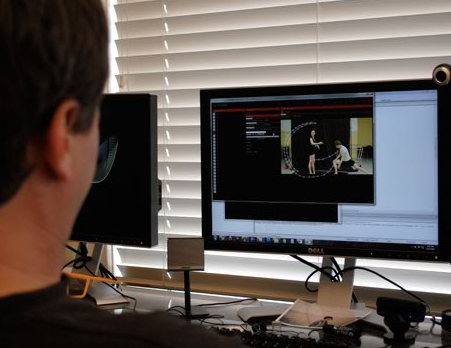
This past Summer, Fashionbuddha teamed up with Oregon Ballet Theatre and Weiden + Kennedy 's WK12 on an interesting project. The message is simply that some of us need to move to think. The goal is to demonstrate that activities such as art, dance, and music which have been getting cut from public schools are just as important to many of us as reading and writing are to others. For a lot of kids out there, these two are inseparable. WK12, admittedly inspired by the car font , came up with the idea to create a font based on the movement of ballet dancers. Oregon Ballet Theatre provided the talent, Fashionbuddha took up tech duties, and WK12 set up a web site and wonderful open house at The Armory in Portland, Oregon. Visit the official Ballet Font web site for more photos, videos, and the story behind it all. CAPTURE OBT worked to choreograph letters using the motion of one or two dancers, often finding creative compromises to better meet WK12's vision or work better with my Chireo. To track the dancer's motion, I came up with a cheap method of taping infrared LEDs to watch batteries, which were then taped to the dancers' hands and feet. I'd even disassembled our first prototype FTIR table to get the LEDs, that's how cheap I am. To capture motion and export it as vector data and rendered videos, I wrote a three-part part series of applications named "Chireo" (chirography + choreography). The first stage was "Chireo Capture". Based on Magnetic and openFrameworks , Capture recorded from two cameras, operated in tandem with a remote controlled Canon EOS 7D . There were twenty-six slots for letters, and each letter could record ten takes. Each take recorded raw video footage from a cheap web cam and x, y coordinates in XML by tracking infrared light with a modified PS3 camera. The webcam footage was recorded to make it immediately available for preview in the UI, as well as confirm which data belonged to which HD video when we took it off the 7D between shoots. Whichever take we liked best, we could mark in the software. AUGMENT Stage two of "Chireo" was "Augment". Augment's first task was to narrow its data down to just the takes we wanted to use. We now had a single XML file and one video for each letter. We'd captured the video on a HD camera, but the tracking data was recorded on a PS3 camera, so the timing and position was a little bit off between the two. There was also some noise that was captured in the tracking data, and some of the strokes did not connect. Augment allowed us to manipulate the scale and time of the overall tracking data, as well as connect and remove nodes or shift nodes in both space and time. With cleaned up letters, I exported SVGs and started on the animation overlay. Todd Greco here at Fashionbuddha helped convert the single line stroke data to more font-like structures in Illustrator. He also wrote the basic particle emitter we'd use for the renders and in the live demonstration at the project's opening, while I worked on the next stage of the software. Test renders from Chireo Augment LIVE The final, and for me the most fun, rendition of this software was "Chireo Live". The project's opening was held on July 1, 2010. That's a first Thursday in Portland where art galleries open each month, ensuring a lot of foot traffic for us. Live leveraged the motion tracking system we'd used to capture the data, but instead of recording anything, it just draws strokes and particles. The application ran on two monitors. The "control panel" ran back stage and let us control numerous parameters with the animation, so the look of it continuously change throughout the night. The other was projected onto a large screen where visitors could see themselves and the lines they drew in the air. We handed out bracelets with infrared LEDs for people to try out in front of a large screen, essentially creating a large augmented reality piece. The final version looked great, running blur and bloom shaders on the strokes and particles to give it a bright, fiery look. I never managed to track down any video from that night, but do have a clip from a test run. Demonstration of Chireo Live The amazing and fun yet challenging and frustrating thing about this project was the lack of time and funding. Trying to make something great of out little-to-nothing would be a consistent theme throughout. It's made us all that much prouder of the end result.

